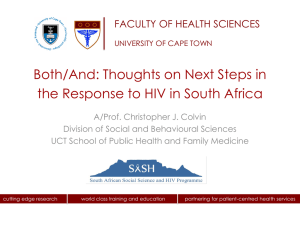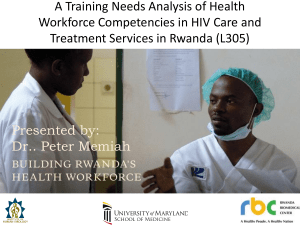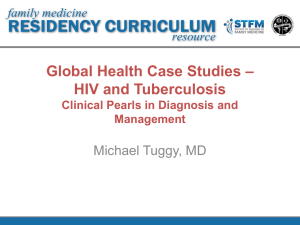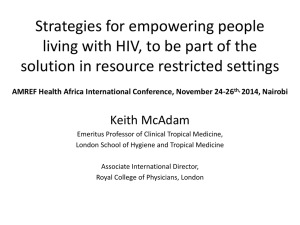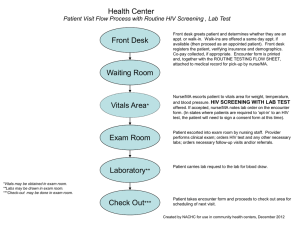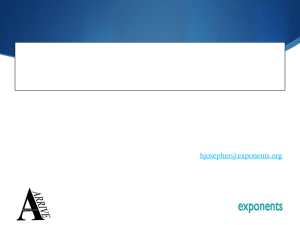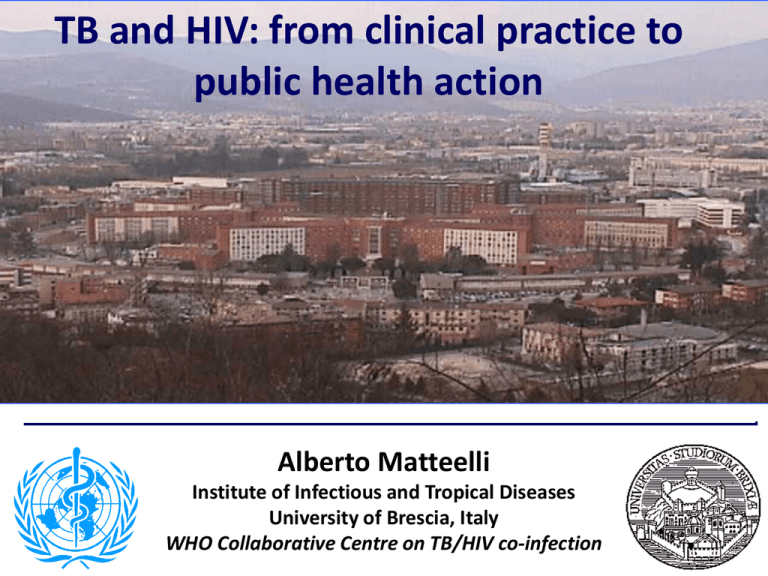
TB and HIV: from clinical practice to
public health action
Alberto Matteelli
Institute of Infectious and Tropical Diseases
University of Brescia, Italy
WHO Collaborative Centre on TB/HIV co-infection
Outline of the presentation
• Burden of HIV associated TB
• Impact of HAART on the epidemiology of HIV
associated TB
• Diagnostic standards and perspectives for HIV
associated TB
• How to treat the TB/HIV co-infection (choice of
drugs, timing, managemert of IRIS)
• Prevention of TB in HIV infected persons (early
diagnosis, IPT, ART)
• WHO recommended TB/HIV activities
How HIV influences the TB natural
history
M. tuberculosis
Relative risk for TB:
HIV neg. = < 10% per lifetime
First
Infection
HIV positive
Re-infection
(exogenous)
HIV pos. ~ 3-7 % per year
Primary
TB
Latent
TB
Reactivation
(endogenous)
Progressive
Primary TB
Post-primary TB
TB/HIV Co-infection
Overlap of two populations
Sub-Saharan African country
Infection
Infection
with HIV
with
M.
tuberculosis
Estimated HIV prevalence in new TB cases,
2009
1.1 million TB/HIV cases and 400,000 deaths
WHO, Global TB report 2010
Estimated annual TB incidence
(per 100K adults, 1999)
Estimated TB incidence vs. HIV prevalence
in high burden countries
1600
1200
800
400
HIV prevalence increases by 1%
TB incidence increases by 26/100k/yr
0
0.0
Williams B. 3rd Global TB/HIV
Working Group Meeting;
Montreux, 4-6 June 2003
0.1
0.2
0.3
HIV prevalence, adults 15-49 years
0.4
Impact of HIV on TB in Africa
4/5 of all estimated TB/HIV cases are in Africa
Notified cases per 100,000 pop. 1980-2008
TB notification rate in 20 African countries* versus HIV prevalence
in sub-Saharan Africa, 1990–2004
200
8
180
7
160
6
140
TB notification
rate per 100,000
population
120
5
100
4
80
3
60
% Adult HIV
prevalence
(15-49)
2
40
1
20
0
0
1990 1991 1992 1993 1994 1995 1996 1997 1998 1999 2000 2001 2002 2003 2004
TB notification rate
HIV prevalence
• Consistently reporting each year: Algeria, Angola, Botswana, Cameroon, Comoros, Congo, Côte d'Ivoire, Democratic Republic of Congo,
Ghana, Guinea, Kenya, Malawi, Mauritius, Mozambique, Nigeria, Senegal, South Africa, Uganda, United Republic of Tanzania, Zimbabwe
Sources: World Health Organization (2006), Global TB database; UNAIDS (2006)
4.5
TB/HIV Co-infection
Overlap of two populations
Rich European Country
Infection
Infection with
with HIV
M. tuberculosis
World Health Organization
Estimated HIV prevalence in new TB cases,
WHO European Region 2008
TB in the HIV era
• Most frequent infection associated with HIV
world-wide
• Can spread to the non-HIV population
• HIV can pull and steer the incidence of TB
Clinical case 1a
16/03/2010: B V, male, 30 years old, from Romania, working in Italy
since 4 years, is prescribed an HIV test because of genital lesions and
oral candidiasis. The test result is positive.
31/03/2010: His viro-immunological profile is as follows: CD4+ 173
(14,4%) HIV-RNA 106,000 copies. HIV treatment is prescribed:
3TC/ABC plus LPV/r.
3/05/2010: the patient develops persistent high fever and is
admitted to the ward
A chest X-ray is performed (03/05)
Abdominal CT scan (07/05)
Clinical case 1b
• TB suspect: sputum and blood samples examined – negative
microscopy
• M.tuberculosis isolated from sputum and blood on 24/05. Rapid
test for rifampicin resistance is negative.
Disseminated TB diagnosed
• 25/05: TB treatment started with RIFABUTIN 150 mg every
other day + INH/ETH/PZA; HAART is continued unchanged
• 06/06: drug sensitivity testing available: resistance to isoniazid.
The drug is removed and the TB regimen continues as planned
• The patient is fully adherent to monthly clinical visits, his
conditions improves and normalise
• 25/11: he completes TB treatment (6 months).
Key features of clinical case 1
• HAART is a significant determinant of the risk
of TB in HIV infected persons
• Smear negative pulmonary TB and
extrapulmonary TB is common
• Treatment of TB in an HIV infected person is
challenging
TB and HIV in the era of HAART
• HAART reduces the incidence of TB by approximately
80% in high and low burden countries
• TB incidence in HIV infected persons receiving effective
HAART is ~ 10 times higher than that in the background
population
• HAART may unmask TB in persons with low CD4 cell
count
• HAART may be key to control MDR epidemics among
HIV infected persons
Recurrent TB and ART in HIV-infected
patients in Rio de Janeiro
Adjusted
Relative Hazard
(95%CI)
P-value
HAART after TB Dx
0.45 (0.26-0.79)
0.005
CD4
(Timedependent)
< 200
200 – 349
350 – 499
≥ 500
1
0.46 (0.27-0.79)
0.47 (0.26-0.85)
0.32 (0.17-0.61)
0.005
0.01
< 0.001
Sex
Male
Female
1
1.03 (0.67-1.60)
0.89
1
0.85 (0.41-1.79)
0.80 (0.38-1.69)
0.26 (0.09-0.75)
0.67
0.56
0.01
Variable
Age
< 30
30-39
40-49
≥ 50
N=1042 – recurrences in 8.9%
Golub et al., AIDS 2008; 22:2527
Changes in tuberculosis (TB) incidence during 3 years of HAART in Europe and
North America with regression curve fitted. TB incidence rate is expressed as
number of cases per 1000 person-years of follow-up
Although the incidence tended to
decrease with time, it was still 150 per
100,000 PYFU during the third year
after starting HAART.
Which is 10-fold higher than in HIV
negative population
Girardi E, Clin Infect Dis 2005, 41: 1772
TB is the commonest illness among PLHIV on
ART
Incidence of tuberculosis among HIV seropositive
patients by timing after initiation of HAART
During the initial months of HAART
incident TB cases may arise as a
consequence of “unmasking” of
previously subclinical disease or the
deterioration of a pre-existing disease
due to the reconstitution of the immune
system (Lawn, 2005)
Dembele M, Int J Tub Lung Dis 2010, 14: 318
Incidence of tuberculosis among HIV seropositive
patients by timing after initiation of HAART and
site of the disease
Dembele M, Int J Tub Lung Dis 2010, 14: 318
Lessons for HIV programmes
• Start ART at early stage (CD4 350 or below)
• Increase capacity to diagnose PTB by
improved microbiological tools
• Increase capacity to diagnose EPTB
(develop algorithms)
Improving diagnostic
capacity
New(er) TB Diagnostic Tools
• LED fluorescent microscopy
• Liquid culture (e.g. MGIT)
– Sensitivity ~50-75% > L-J
• Capilia TB
– Rapid strip test that detects a TB-specific
antigen from culture
• Molecular assays
– Cepheid GeneXpert
– Hain GenoType MTBDRplus)
LED microscopy
Molecular assays
Liquid culture
Xpert MTB/RIF
Boehme et al. N Engl J Med 2010; 363: 1005
Among culture-positive patients, a single, direct MTB/RIF test
identified 551 of 561 patients with smear-positive TB (98.2%)
and 124 of 171 with smear-negative TB (72.5%).
The test was specific in 604 of 609 patients without
tuberculosis (99.2%).
MTB/RIF testing correctly identified 200 of 205 patients
(97.6%) with rifampin-resistant bacteria and 504 of 514
(98.1%) with rifampin-sensitive bacteria.
Proportion of TB cases detected and
time to detection
Courtesy of C Gilpin
Current understanding of Xpert TB
contribution to TB control
• Increases sensitivity of 30% compared to
miscroscopy
• Reduces time to start TB treatment
• Might have an impact on mortality
• Logistic is manageable
• Costs per TB case detected increases x 3 times but
remains cost-effective with WHO criteria (<1
GDP/capita)
• Impact on EPTB and pediatric TB under investigation
Treatment of TB in HIV
infected persons
Strategy for initiation of TB treatment
in HIV infected patients with active TB
TB treatment should be started
immediately under all
circumstances
WHO, 2010: Rapid Advice on ART
Treatment of Tuberculosis in HIV
Daily or 3 times weekly therapy only
Initial Phase
Continuation Phase*
Isoniazid
Rifampin
Pyrazinamide
Ethambutol
0
1
2*
3
4
5
months
6
7
8
9
*If culture positive at 2 months and cavitation, extend therapy to 9 months
CDC , ATS and Infectious Diseases Society of America Guidelines
Does 6-month therapy duration
increase the risk of relapse ?
Pooled estimate of relapse result stratified by duration of rifampin
DURATION
OF
RIFAMPIN
2 months
N. STUDIES
N.
RELAPSES
6
40/258
POOLED
RELAPSE RATE
(95% CI)
10,8 (0-25,1)
aRR
(95% CI)
6 months
12
100/730
9,8 (0-19,8)
2,4
(0,8-7,4)
> 8 months
6
20/314
3,3 (0-9,0)
1,0
(reference)
3,6
(1,1-11,7)
Khan FA, AIDS 2010 (methanalysis)
Programmatic outcomes for TB/HIV
patients are poor
WHO Global TB Report, 2009
Choice of HIV drugs
ART for HIV/tuberculosis co-infection
WHO recommendation
• Use efavirenz as the preferred non nucleoside
reverse transcriptase inhibitor in patients
starting ART while on treatment
(strong recommendation – High quality of
evidence)
WHO, 2010: Rapid Advice on ART
Efavirenz, no doubts
Advantages
Is a first line option for HIV treatment
In the most widely used first line drug in resource
limited settings
Allows for standard TB therapy
Allows for once a day therapy with minimal pill
burden (Atripla)
Clinical trials available from South Africa and
Thailand
EFV dose in TB/HIV co-infection treated
with RMP (600 versus 800 mg)
• Reduction in EFV levels:20-25%
• Clearance of EFV lower in in Afro-Americans and Hispanics
than Caucasians (impact on safety profile); body weight also
important (60 kg threshold)
• In Caucasian > 60 Kg EFV 800 mg + RIF give AUC similar to EFV
600 mg
• In Thailand and South Africa studies show effective,
pharmacological, clinical, immunological and virologic
response with conventional 600 mg EFV dose
What if efavirenz cannot be used ?
Effect of RFM on Serum Concentrations of PIs and NNRTI
PI
NNRTI
Saquinavir
80%
Nevirapine
37-58%
Ritonavir
35%
Efavirenz
13-26%
Indinavir
90%
Nelfinavir
82%
Amprenavir
81%
Lopinavir/ritonavir
75%
Atazanavir
not done
Rifabutin and HIV drugs of the PI class
Available data allows for the use of LOPINAVIR, ATAZANAVIR,
FOSAMPRENAVIR, DARUNAVIR, TIPRANAVIR always with
RITONAVIR boosting
PI blood level adequate to ensure efficacy (but few
datafrom clinical trials)
Ritonavir increases rifabutin levels significantly, requiring
a dose reduction to 150 mg every other day (DHHS)
This recommendation is derived from PK studies in
healthy volunteers
Rifabutin 150 mg every other day in
association with Lopinavir/r
• 9/10 patients with low Cmax values (<30mg/ml)
(Boulanger C, CID 2009
• 5/5 patients with low Cmax values (<45mg/ml)
Khaci H, JAC 2009)
• AUC significantly reduced compared to the
standard in 16 TB/HIV patients in South Africa.
AUC reverted by 150 mg daily during LPV/r
treatment
Naiker S, 18° ICAAR, 2011
Ryfamicin resistance
• Monoresistance described almost exclusively
in HIV infected patients
• Associated with intermittent ryfamicin use
(rifapentine, probably for low drug blood
levels)
Rifabutin low blood levels may carry a risk for
selection of rifamycin-resistant M.tuberculosis
Current dosing recommendation for rifabutin in
association with LPV/r likely to need revision
Drug Interactions: Rifampicin and
other HIV drugs
• NNRTIs
– Rifampicin decreases Etravirin exposure
“significantly”. Combination not recommended
• CCR5 Inhibitors
– Rifampicin reduces maraviroc exposure by
63%. Maraviroc doses could theoretically be
doubled but no clinical experience
• Integrase inhibitors
– Rifampicin reduces raltegravir exposure by 4060%. Raltegravir 800 mg BID suggested, but
optimal concentration range of this drug is
unknown
Drug Interactions: Rifabutin and
other HIV drugs
• NNRTIs
– No significant interactions with efavirenz and
nevirapin (but no advantage over rifampicin).
With efavirenz rifabutin dose need to be
increased to 450 mg daily
• Integrase inhibitors
– Rifabutin does not alter raltegravir exposure to
a clinically meaningful degree (Brainard DM et
al. J Clin Pharmacol 2010)
• CCR5 Inhibitors
– No clinical data
Clinical case 2a
C. L. female, 27 years old, originating from Dominican Republic. Known HIV infection
since 2005. HBV/HDV co-infections. Default from follow-up and HAART in 2007.
On 06/07/2010 admitted to the clinical ward for fever and cough since three
months, irresponsive to antibiotic therapy.
A chest X-ray is performed:
Sputum examination: AFB seen, Pneumocystis jirovecii seen
Molecular test: M.tuberculosis, no resistance markers to rifampicin
Clinical case 2b
Smear positive pulmonary TB
PCP
CD4 cell count = 27; HIV-RNA 157,000 copies
On 07/07 starts standard antituberculosis treatment with
Rimstar 4 tabs /day
On 26/07 starts HAART using TDF/FTC plus + EFV 800 mg once a
day
Discharged on 03/08 in good clinical conditions and no signs of
toxicity
Clinical case 2c
On 16/08 admission to the clinical ward for re-emergence of high fever
and cough since 3 days. A lung CT is performed.
Clinical case 2d
Adherence to TB treatment reported as optimal. Drug-sensitive TB
Concomitant opportunistic infections ruled out
Other bacterial infections not detected
CD4 cell count = 54; HIV-RNA 600 copies
On 20/08 metilprednisolone 1,5 mg / Kg /day was started
On 01/09 the patient is discharged afebrile, in good clinical
conditions, continuing TB, ARV and steroid treatment at home
Key features of clinical case 2
• Do TB/HIV patients need ART ?
• Timing of ARV in TB/HIV patients
• The risk of the immune reconstitution
syndrome (IRIS) and its relevant characteristics
• Management of the IRIS
Do TB/HIV patients
need ART ?
SAPiT Trial: Initiating ART during TB
treatment significantly increases survival
ART initiation during TB
treatment
(n = 429)
Median
67 days
ART initiation after TB
treatment (n = 213)
Median
261 days
HIV-pos with TB and
CD4+ < 500 cells/mm3
(N = 642)
Primary Endpoint: mortality rate (any cause)
Abdool Karim SS, N Engl J Med 2010; 362:697-706
Timing of Initiation of Antiretroviral Drugs
during Tuberculosis Therapy: the SAPiT trial
• HR for mortality in arm A = 0.45 (0.26
– 0.79) p=0.005 for any CD4
• HR = 0.54 for CD<200
• HR = 0.08 for CD4>200
Trial stopped by the ethical committee
Abdool Karim SS, N Engl J Med 2010; 362:697-706
Timing of ART in HIV/tuberculosis
patients
WHO recommendation
• Start ART in all HIV infected individuals with
active tuberculosis irrespective of CD4 cell
count
(strong recommendation – Low quality of evidence)
WHO, 2010: Rapid Advice on ART
Timing for ARV in TB
patients
Early (2 weeks) vs. late (8 weeks) initiation of HAART:
the CAMELIA study (Blanc et al).
Kaplan-Meier
Survival curve
CONCLUSION: Mortality was
reduced by 34% when HAART was
initiated 2 weeks vs 8 weeks after
onset of TB treatment
Timing of ART during TB therapy
Trial
ACTG 5221
STRIDE
study
(1)
Sites and
patients
Study design and
endpoint
Overall
results
Multicentre in 4
continents
(majority in
Africa).
Immediate (2 w) Vs.
early (8 w)
13.0%
Vs.16.1%
P=0.45
<500 CD4
15.5% Vs.
26.6%
Death+AIDS events
at W48
The Camelia study:
the median
TB suspect
or
of the CD4 cellc
count of
confirmed
enrolled patients
<250was
CD425 cells
One centre in
SAPiT
continuation South Africa
phase
Smear+PTB
(2)
Results in
CD4<50
P=0.02
STRIDE and SAPiT trials: for CD4>
50 there was no trend towards
decreased death/AIDS events
Early (1-4 w) Vs. late
(8-12 w)
Death+AIDS events
at W48
6.9 Vs. 7.8
/100 p-y
P=0.73
8.5 Vs. 26.3
/100 p-y
P=0.06
(1) Havlir D, et al. Abs 38, 18° CROI, Boston 2011
(2) Abdool Karim S, et al. Abs 39LB, 18° CROI, Boston 2011
ART Initiation in TB Meningitis – A
Randomized Trial in Vietnam
• Immediate – ART within 7 days after TB
initiation
• Deferred – ART initiated 2 months after TB
initiation
Immediate
Deferred
Number
127
126
Died
76
70
Survival
40%
45%
p=0.52
Torok et al. ICAAC 2009, Abstract H-1224
Timing of ART in HIV/tuberculosis
patients
WHO recommendation
• Start TB treatment first, followed by ART as
soon as possible after starting TB treatment
(strong recommendation – Moderate quality of
evidence)
WHO, 2010: Rapid Advice on ART
Optimal timing of ART among TB
patients – what is the evidence ?
• ART should be started within 2 weeks from TB
therapy in TB/HIV patients with CD4 < 50
• ART can be delayed up to the end of the
intensive phase of TB treatment in TB/HIV
patients with CD4>50
What if CD4 cannot be measured – or timely
measured ? Unclear at this time
Expected mortality should steer decision
on optimal timing of combined TB and
HIV therapy
Risk of death
while awaiting
HAART
Risk of death as a
consequence of
HAART (IRIS)
Combined HAART and treatment for
tuberculosis
Constraints
Increased rate of paradoxical reactions (IRIS)
Additive toxicity
Reduced adherence
Operational delays
Definition of IRIS
(A) Antecedent requirements
• Diagnosis of tuberculosis before starting ART
• Initial response (stabilised or improved) to tuberculosis treatment
(B) Clinical criteria
• Onset of manifestations within 3 months of ART
Plus at least one major or two minor criteria
Major criteria
1) New or enlarging lymph nodes, or similar cold abscesses, 2) New or worsening
radiological features of TB; 3) New or worsening CNS TB; 4) New or worsening
serositis
Minor criteria
1) New or worsening constitutional symptoms; 2) New or worsening respiratory
symptoms; 3) New or worsening abdominal pain
(C) Alternative explanations for
excluded if possible
clinical deterioration must be
• Failure of tuberculosis treatment because of tuberculosis drug resistance
• Poor adherence to tuberculosis treatment
• Another opportunistic infection or neoplasm
• Drug toxicity or reaction
Meintjes G et al. Lancet ID 2008; 8-516
TB IRIS
Do patients die because of IRIS ?
3·2% (0·7–9·2) of patients with
tuberculosis-associated IRIS died
Muller M, Lancet Infect Dis, 2010 10: 251 (metanalysis)
Management of IRIS
• Make certain of diagnosis
– Rule out MDR TB or new opportunistic infection
•
•
•
•
•
TB treatment should be continued
ARV treatment should be continued
Surgical drainage
Non-steroidal anti-inflammatory drugs
Steroids – 1.5 mg/kg prednisone
Corticosteroids and IRIS outcome
• 109 TB/HIV patients with clinical definition of IRIS in South
Africa
• Randomised, placebo controlled trial of 1.5 mg/kg/day (2
weeks) + 0.75 mg/kg/day (2 weeks)
• Cumulative # hospital days 282 Vs. 463
• Median # hospital stay 1 Vs. 3 (p=0.05)
Meintjes G, AIDS, 2010
Overlap of Adverse Reactions from Drugs
Used to Treat TB and HIV Infection
Adverse Reaction
TB Drugs
HIV Drugs
Rash
PZA, RIF, INH
NNRTIs, ABC, T/S
Hepatotoxicity
INH, RIF, PZA
PIs, NVP
Nausea
RIF, PZA, INH
RTV, AZT, APV
RBT, RIF
AZT, T/S
INH
EFV
Cytopenias
CNS
Side effects of TB treatment and HIV
infection
• Most studies demonstrate an increased rate of
side effects during TB therapy among HIV
infected persons
• In randomised trials of combined TB and HIV
therapy, toxicity was a very unlikely cause of
treatment discontinuation
ART in TB patients by Region, 2008
Region
AFR
AMR
EMR
EUR
SEAR
WPR
started on ART
30%
67%
55%
29%
35%
28%
Operationalising ART in TB patients
• Rapid HIV diagnosis
• Rapid CD4 determination (or identificatioon of
surrogate markers – BMI,Hb, clinical or
radiological signs)
• Avalability of ART (often requires referral and
loss during referral or delay)
• Instruct on how to identify and manage IRIS
• Prevention of IRIS ?
Prevention of HIV
associated TB
- Early diagnosis
- IPT
- ARV
Policies for regular TB screening
among PLWHA
• Educating health workers to early recognition
of TB symptoms in PLWHA
• At every consultation in chronic HIV care:
– Searching for signs (cough)
– Searching for symptoms (clinical examination)
• If necessary: second level investigations
(sputum microscopy, Chest X-ray)
WHO 2010 IPT/ ICF recommendations
Does the WHO algorithm for Screening HIV
Patients work ?
• Presence of symptoms – work up for
TB
– Sensitivity 79%
– Specificity 56%
• Absence of symptoms – proceed with
INH preventive therapy
– Negative predictive value 97%
Getahun H et al. Plos Med 2011; in press
Treatment of latent tuberculosis
infection
Current standard (IPT):
• Isoniazid 300 mg /daily for 6-9 months
Efficacy of IPT
compared with
placebo, in
reducing the
incidence of
active TB
Akolo C, et al. Cochrane Review, 2010
Treatment of latent tuberculosis
infection
Research perspectives:
• Shorter regimens
• Drugs with no baseline resistance
• Well tolerated
In high burden countries, where risk of
re-infection is high:
• Operationalising IPT
Efficacy of 36 vs. 6 months of INH for
HIV-infected Adults in Botswana
The BOTUSA Trial
Samandari et al., IUATLD Conference, December 2009
Can IPT increase resistance to INH ?
• There is no evidence that IPT can increase
resistance to INH provided that active disease
is ruled out
• Directly observed administration of INH is not
essential, although poor adherence will limit
the impact of IPT
Is IPT safe ?
The Botswana NTP / CDC IPT study
• Of 1,762 patients in analysis 19 (1.2%) developed
hepatitis (grade 3 or above). One patienst died. (1)
• Low rate of severe adverse events after the first six
months of IPT: 7 (0.9%) in the 6-IPT arm (placebo)
and 11 (1.3%) in the 36-IPT arm (2)
• Coadministration with ART slightly increased liver
toxicity (RR 1.59 [0.63-4.0]). Risk greater on
nevirapine (RR 2.09 [0.74 - 5.87]) than efavirenz (RR
0.96 [0.21 - 4.31]).
Clinical monitoring appropriate for safety of IPT
1. Tedia Z et al, Am J Respir Crit Care Med 2010; 182:278
2. Samandari T, 40 IUATLD Conference, Cancún, 2009
Eligibility for IPT
In areas of high prevalence of TB (>30% infected):
All HIV infected individuals who are not affected by
active TB
In areas of lower prevalence of TB (<30% infected):
HIV infected individuals with a positive PPD test who
are not affected by active TB
Independently from CD4 cell count
36 vs. 6 months of INH for HIV-infected
Adults in Botswana -The BOTUSA Trial
Samandari et al., IUATLD Conference, December 2009
The probability of a positive TST test is
associated to the level of immune suppression
Elzi et al CID 2007
Do IGRAs help for screening of LTBI in
HIV+ subjects ?
Current evidence suggests that IGRAs perform similarly
to the tuberculin skin test at identifying HIV-infected
individuals with latent tuberculosis infection. Given
that both tests have modest predictive value and
suboptimal sensitivity, the decision to use either test
should be based on country guidelines and resource
and logistic considerations.
Cattamanchi A, et al. JAIDS 2011; 56:230-8
TB Rates by ART and INH
Treatment Status, 2003-2005
Exposure
category
Percent
Reduction
(95% CI)
Person-Years
TB Cases
Incidence Rate
(per 100 PYs)
No Rx
3,865
155
4.01 (3.40-4.69)
-
ART only
11,627
221
1.90 (1.66-2.17)
52%
(41-61%)
IPT only
395
5
1.27 (0.41-2.95)
68%
(24-90%)
Both
1,253
10
0.80 (0.38-1.47)
80%
(9-91%)
Total
17,140
391
2.28 (2.06-2.52)
Golub et al., AIDS 2007;21:1441-8
TB Rates by ARV and INH Treatment Status in
South African Adults with HIV Infection
Exposure
category
Person
TB
-years cases
Incidence rate
(per 100 PYs)
(95% CI)
Incidence rate
ratio (95% CI)
Adjusted
hazard ratio*
(95% CI)
REF
REF
Naïve
2815
200
7.1 (6.2-8.2)
HAART
only
952
44
4.6 (3.4-6.2)
0.65 (0.46-0.91) 0.36 (0.25-0.51)
INH only
427
22
5.2 (3.4-7.8)
0.73 (0.44-1.13) 0.87 (0.55-1.36)
Both
93
1
1.1 (0.2-7.6)
0.15 (0.01-0.85) 0.11 (0.02-0.78)
4287
267
6.2 (5.5-7.0)
TOTAL
* Adjusted for age, sex, CD4, prior history of TB, urban/rural
Golub et al, AIDS 2009;23:631-6
New TB screening and IPT guidelines
• TB screening and IPT in tandem
• Symptom based clinical algorithm for TB
screening developed: 4 simple questions
• INH for 6 (strong) and 36 (conditional)
months recommended
• Pregnant women, children and people
receiving ART included
• TST is not a requirement
• Should be a core function of HIV services
WHO recommended
TB/HIV collaborative
activities
Policy on collaborative TB/HIV activities
WHO recommendations 2004
A. Establish NTP-NACP collaborative mechanisms
Set up coordinating bodies for effective TB/HIV activities
at all levels
Conduct surveillance of HIV prevalence among TB cases
Carry out joint TB/HIV planning
Monitor and evaluate collaborative TB/HIV activities
B. Decrease burden of TB among PLHIV (the "3 Is")
Establish Intensified TB case finding
Introduce INH preventive therapy
Ensure TB Infection control in health care and congregate
settings
C. Decrease burden of HIV among TB patients
Provide HIV testing and counselling
Introduce HIV prevention methods
Introduce co-trimoxazole preventive therapy
Ensure HIV/AIDS care and support
Introduce ARVs
The 12 points package: what is new?
A. Establish the mechanism for integrated TB& HIV services
Set up coordinating bodies for effective TB/HIV activities
at all levels
Conduct surveillance of HIV prevalence among TB cases
Carry out joint TB/HIV planning
Conduct monitoring and evaluation
B. Decrease burden of TB among PLHIV (the "3 Is")
Establish Intensified TB case finding and ensure quality TB treatment
Introduce TB prevention with IPT or ART
Ensure TB Infection control in health care and congregate
settings
C. Decrease burden of HIV among TB patients
Provide HIV testing and counselling to TB suspects & TB patients
Introduce HIV prevention methods for TB suspects & TB patients
Provide CPT for TB patients living with HIV
Ensure HIV prevention; treatment & care for TB patients with HIV
Introduce ARVs to TB patients living with HIV
World Health Organization
TB/HIV co-infection,
WHO European Region 2008
HIV case finding among TB:
• HIV testing coverage = 79% (~ 357.000 patients)
• HIV prevalence among tested TB = 3% (~ 11.500
patients)
• Estimated HIV prevalence = 5.6% (~ 23.800 people)
• 48% of TB/HIV patients are detected
TB/HIV co-infection,
WHO European Region 2008
Management of TB/HIV co-infected patients:
• 61 % of TB/HIV patients are covered by CPT
• 9.2 % covered by IPT
• 29% of TB/HIV patients are covered by ARV
treatment
TB/HIV co-infection,
WHO European Region 2008
TB case finding among PLHIV:
• estimated TB prevalence among PLHIV = 1.7%
• screening coverage for TB = ??? (~205 000)
Challenges and response
The Health Structure
1. Extreme verticality of the TB and AIDS
programmes both in service provision and
management;
2. Lack of effective coordinating mechanisms for TB
and HIV
Challenges and response
TB/HIV/IVDU convergence
Challenges and response
TB/HIV in marginalised populations
Prisoners
Migrant people
Challenges and response
Convergence of TB/HIV and MDR-TB
Increasing convergence of drug resistant TB and HIV in
the region and the lack of understanding of the
extent of the problem.
Efforts to address drug resistant TB in the region need
to be scaled up and integrated with HIV prevention
and treatment services.
TB/HIV Working Group of the Partnership
Focus on European Region, Almaty, May 2010
Outcomes of Treatment for MDR TB in the
South African DOTS-Plus Program, 2002-2004
Outcome
HIV +
(N=327)
38.5%
HIV –/unknown
(N=875)
49.3%
P value
Failed
4.3%
11.4%
<0.001
Defaulted
21.4%
22.6%
0.65
Died
35.8%
16.7%
<0.001
Successful Rx
Farley, van der Walt, et al., IUATLD World Conference, 2007
<0.001
Thank you for your attention

